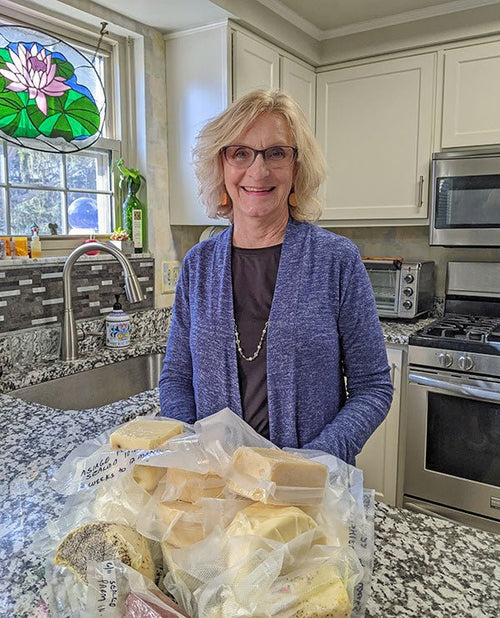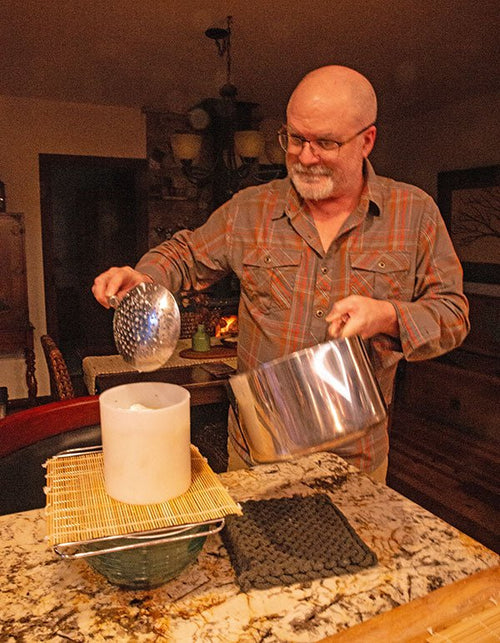“A Garden for the House” and a Mozzarella for the fridge …
We currently have 8 articles on this blog about making 30 Minute Mozzarella. This is the 9th and I will keep on posting them until you (and you know who you are) finally give it a try. It’s soooo easy!
And, if a busy man like Kevin Jacobs can find the time to make it, that says a lot. He wouldn’t bother doing it if it wasn’t worth it, right?
Speaking about how busy Kevin is, have you been to his website lately? There’s a lot there! His gardening section is huge, but there’s a whole lot more, including some great recipes, decorating tips, a tour of his fabulous home (built in 1826), and his very own forum- “Ask Kevin.”
When he’s wearing his cheese making hat, Kevin makes his own ricotta, cream cheese, cottage cheese and now mozzarella:
WHAT’S MORE FUN THAN A BARREL OF MONKEYS? Making your own mozzarella cheese. I made the shiny, perfectly-textured, unbelievably delicious loaf pictured up top in only 30 minutes. The ingredients are as simple as the recipe:
Homemade Mozzarella
Based on a recipe by Ricki Carroll
Ingredients for about 1 pound
1 gallon whole milk, not “ultra pasteurized”
1 1/2 tsp. non-gmo citric acid*
1/4 tablet rennet*
1 tsp. salt (optional)
Water (non-chlorinated)
* You can obtain rennet and citric acid from healthfood stores, or you can order them online, as I did, in a kit from The New England Cheesemaking Company. Do not use “Junket” rennet — it is too weak for mozzarella-making.
Special Equipment
A heavy-bottomed, stainless steel or enameled pot which will hold at least 6 quarts; a thermometer; a large slotted spoon; a knife which will reach the bottom of the pot; a colander. Also, a microwave oven OR a large pot of water, heated to 185F.
Preliminaries – dissolve 1/4 tablet rennet in a 1/4 cup cool water; mix 1 1/2 tsp. citric acid in 1 cup cool water
1. Pour milk into pot; stir while adding the citric acid mixture.
2. Heat the milk to 90F, stirring all the while.
3. Remove pot from heat; slowly stir in the rennet solution, using an up-and-down motion with your slotted spoon. Cover and let rest for 5 minutes. Then inspect the curd; it should resemble a custard if pressed gently with your finger.
4. Using your knife, slice the curd criss-cross into one-inch squares as if you were slicing brownies.
5. Return the pot to the flame, and heat to 105F as you slowly stir the curds with your spoon.
6. Remove from heat and continue to stir for 2-5 minutes. The more you stir, the firmer the cheese will be.
7. Pour into a colander in order to drain off the liquid, or whey, from the curd. Save the whey, if you wish, and use it in place of water for your next bread-baking adventure.
Note: At this point, if you are not going to use a microwave oven to heat the curds, scroll down for Hot Water Bath directions
8. Pour curds into a microwaveable bowl. Holding the curds with one hand, tilt the bowl to drain off as much of the whey as you can.
9. Microwave on “High” for exactly one minute. Drain off the whey, and fold, with your gloved hands, the curds into one piece. (Okay, I didn’t wear gloves. But you should.) Then add the optional salt.
10. Microwave again for 30 seconds, drain again, and then place the solid mass on your work surface. Knead just as you would bread, folding the cheese over on itself. Keep kneading until the cheese turns glossy, and looks, well, like mozzarella. If the cheese doesn’t hold together well, give it another 30-second spin in the microwave, or until the cheese reaches 135F. You’ll know the cheese is ready when you can stretch it into a long strand.
11. Form the cheese into a loaf, a ball, or a bunch of little bite-size balls. If you like braided cheese, by all means have at it.
12. To finish, submerge the cheese in a bowl of ice water for 15 minutes. This will insure the cheese holds its shape, and maintains its smooth, silky texture.
You can eat the cheese immediately, or refrigerate it in an air-tight container for up to 2 weeks. For longer storage, wrap the cheese tightly in plastic wrap, and freeze it.
Hot Water Bath Directions:
Heat a pot of water to 185F. Ladle the curds into a colander, folding the curds gently as you drain off the whey. Dip the colander of curds into the hot water. After several times take a spoon and fold the curds until they start to become elastic and stretchable. This happens when the curd temperature reaches 135F. Remove the curd from the liquid and pull like taffy. This stretching elongates the proteins. If it does not stretch easily, return to the hot water bath for more heating. Then proceed with kneading, as described in Step 10.





















































































































































